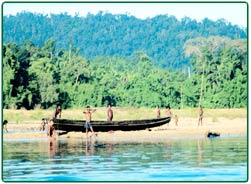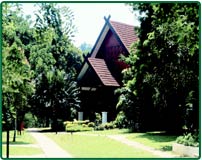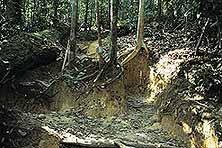|
A
Unique Environment
Taman
Negara, which means 'national park' in Malay, became a park in 1939
when Malaysia was still a British colony. With an area of 4,343
km2, Taman Negara is twice the
size of Luxembourg. Untouched by the ice ages that transformed the
landscapes of other countries, this environment has remained largely
unchanged for 130 million years, making it the world's oldest tropical
rain forest. Today, a 15 hectare resort in a forest clearing within
the park is one of Malaysia's top tourist attractions. However,
the Wildlife and Parks Service that manages the park have a major
challenge to develop facilities sustainably.This is a delicate balancing
act. On the one hand, they have to consider the needs of visitors
but at the same time ensure that the local people and the environment
do not suffer long-term damage.
 |
Orang
Asli on the river bank
About
200 Orang Asli are allowed to live within the park. The Orang
Asli have lived nomadically in the forest for thousands of
years. They are the only people who are allowed to grow crops,
fish in the rivers, and hunt small animals like monkeys inside
the park.
|
|
�
Simon Scoones/Worldaware
|
�
What
might visitors see when they visit Taman Negara? Click
here to find out.
|
|
Accommodation
at Taman Negara resort

|
Benefits
for the guests and the hosts
Visitors can explore the park along the 200 km of walking
trails, spot wildlife from observation hides in forest clearings
or enjoy boat trips along the network of rivers. This way,
they can gain first-hand experience of a primary
rainforest environment. Meanwhile, local people can benefit
from new job opportunities as hotel staff, boat operators,
tour guides and as part of the Wildlife and Parks Service.
People that live on the edge of the park benefit too. Shops
and services for tourists have sprung up to take advantage
of this honeypot.
|
|
�SimonScoones/Worldaware
|
�
What
might visitors see when they visit Taman Negara? Click
here to find out.
Managing
visitor pressure
Every
year, visitor numbers continue to rise as the park is now open
all year round. The added pressure of more visitors on the resources
of Taman Negara makes the job of the Wildlife and Parks Service
increasingly difficult. By limiting footpaths to only 5% of the
park, most of the environment remains undisturbed by visitors.
However, the downside of this is that visitor pressure is concentrated
in certain areas, particularly around the resort. Here, some animals
have been frightened by the noise of visitors, and have fled to
unprotected areas outside the park where they are more vulnerable.
The Orang Asli's lifestyle is changing too. Their culture is being
commercialised as it becomes a tourist attraction.
�
|
Click
on the image for a larger picture

�Simon Scoones/Worldaware
|
Around
the resort, erosion of the popular footpaths is severe, and
tropical rainshowers quickly remove soil already loosened by
trampling feet. |
Success
in Sustainable Development
Despite
the difficulties, the Wildlife and Parks Service has successfully
managed the park in many ways.
- To
find out how The Wildlife and Parks service tackle the problem
of waste, click
here
- Click
here to find out about one success story in sustainable development
in Taman Negara.
The
Wildlife and Parks Service also draws on the expertise of the Orang
Asli's detailed knowledge of the environment, gathered over generations.
The Orang Asli are the best people to consult when it comes to checking
on the condition of existing walking trails and identifying routes
for new ones. They can also help to identify changes in the location
and behaviour of the wildlife.
Although
sustainable
development is a never ending battle for the Wildlife and Parks
Service, managers of other tourist honeypots
could learn from the experience of Taman Negara.
|

